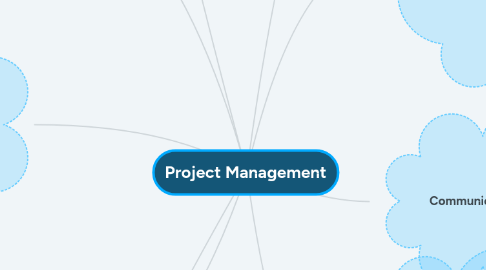
1. Cost Management
1.1. - developing and managing the project budget
1.1.1. Project managers must make sure that their projects are well defined, have accurate time and cost estimates, and have a realistic budget that they were involved in approving
1.1.2. One approach to cost estimating uses the WBS to estimate all costs (capital, expense, and cross-charge) associated with the completion of each task.
1.1.2.1. Typical Problems with IT Cost Estimates 1. Developing an estimate for a large software project is a complex task requiring a significant amount of effort. 2. The people who develop software cost estimates often do not have much experience with cost estimation, especially for large projects. (and no available project data). 3. Human beings have a bias towards underestimation. 4. Management might ask for an estimate, but really desire a number to help them create a bid to win a major contract or get internal funding.
2. Quality Management
2.1. - ensures that the project will meet the needs for which it was undertaken - quality assurance and quality control
2.1.1. Quality planning: determining which quality standards are relevant to the project and determining how will they be met
2.1.2. Quality assurance: evaluating the progress of the project on an ongoing basis to ensure that it meets the identified quality standards.
2.1.3. Quality control: checking project results to ensure that they meet identified quality standards.
3. Human Resource Management
3.1. - making the most effective use of the people involved with the project - compromises are often made
3.1.1. The project manager may be assigned all the members of the team, or may have the luxury of selecting all or some team members
3.1.2. Different Models: - Tuckman’s Team Development Model - Wilson Learning Social Style Profile
4. Risk Management
4.1. - identify, analyze and manage project risks - avoid the risk or develop a backup plan - one of the biggest risk: little value to show in return- a strong rationale should exists for doing it
4.1.1. Risk: uncertain event or condition that, if it occurs, has a positive or negative effect on a project objective
4.1.2. In creating a new IT-related system, a known risk might be that the hardware will take longer than expected to arrive at the installation site.
4.1.3. One strategy is to avoid the risk altogether, while another is to develop a backup plan. The risk management plan can be documented (description, risk owner, risk strategy, and current status)
5. Project Integration Management
5.1. - requires the assimilation of all eight other project management knowledge areas - requires the coordination of all appropriate people, resources, plans, and efforts to complete a project successfully
6. Scope Management
6.1. - defining the work that must be done as part of the project - controlling the work to stay within the scope to which the team has agreed
6.1.1. Scope: refers to all the work involved in creating the products of the project and the processes used to create them
6.1.2. To avoid problems associated with a change in project scope, a formal scope change process should be defined before the project begins
6.1.3. The more flexibility you allow for scope changes, the more likely the project will meet user needs for features and performance
7. Time Management
7.1. - estimating a reasonable completion date - developing a workable project schedule - ensuring the timely completion of the project
7.1.1. Time is one variable that has the least amount of flexibility
7.1.2. The development of a work breakdown structure (WBS) is a critical activity needed for effective time management.
7.1.3. WBS is the outline of the work to be done to complete the project, by breaking the project into various stages or groups of activities that need to be performed.
8. Communications Management
8.1. - the generation, collection, dissemination, and storage of project information in a timely and effective manner - key stakeholders: champion, sponsor, end users, project team members
8.1.1. In preparing a communications plan, the project manager should recognize that the various stakeholders have different information needs in the project.
9. Procurement Management
9.1. - involves acquiring goods and/or services for the project from sources outside the performing organization - make or buy decision, in-house production vs. outsourcing
9.1.1. Procurement: acquiring goods and/or services from an outside source (purchasing)
9.1.2. The make-or-buy is a key decision during the plan purchase and acquisition process. It involves comparing the pros and cons of in-house production versus outsourcing of a given product or service.
9.1.3. A contract is a legally binding agreement that defines the terms and conditions of the buyer-provider relationship, including who is authorized to do what, who holds what responsibilities, costs and terms of payment, remedies in case of breach of contract, and the process for revising the contract

